We present a 37-year-old man who underwent coronary artery bypass grafting for severe left main stem stenosis and right coronary artery disease and was found to have left pleuropericardial agenesis with luxation of heart to the left in the left common pleuropericardial cavity. Although complete absence of pericardium is found in one out of 14,000 patients, agenesis of left pericardium as well as left pleura is extremely rare. Despite a number of related and unrelated pathologies having been described with this condition, there are only two or three reports of co-existence of coronary artery disease. We describe the technicalities of coronary artery surgery in this condition and also review the literature for clinical diagnosis, associated conditions and complications.
Introduction
Left pleuropericardial agenesis is a developmental abnormality that results in the heart and the left lung sharing a common coelomic cavity. This abnormality manifests due to failure of mesodermal ingrowth from the lateral body wall to close off the left pleuropericardial canal and also the failure of development of the left pleuropericardial membrane. Although pre-operative diagnosis is very unusual, partial agenesis can precipitate catastrophic complications of chamber or appendage incarceration. Complete agenesis results in incompletely understood effects on the right ventricular geometry due to luxation of heart into an extreme left ‘intracoelomic’ position with occasional tricuspid valvular regurgitation. Although left pleuropericardial agenesis co-exists with a number of related or unrelated pathologies, concomitant presence of coronary artery disease, although extremely rare, does mandate alterations in operative strategy.
Case presentation
A 37-year-old man presented with non-ST-elevation myocardial infarction (NSTEMI). Risk factors included hypertension, hypercholesterolaemia, smoking and family history of ischaemic heart disease. Other comorbidities included alcoholism, past history of intravenous drug abuse, well-controlled schizophrenia and hypothyroidism. Patient had presented 10 years ago with a road traffic accident while riding a motorbike, resulting in mid sternal fracture and liver laceration, both of which had been managed conservatively. An echocardiogram following the sternal fracture had revealed moderate tricuspid regurgitation with mildly dilated right heart chambers and the patient was advised to be kept under surveillance. Unfortunately, he did not report for follow-up thereafter until he presented with NSTEMI 10 years later. Chest X-ray, at the latest admission, was unremarkable. Electrocardiogram (ECG) revealed left axis deviation and shifting of isoelectrical R wave to V5 (figure 1). Coronary angiogram showed severe left main stem stenosis and severe right coronary stenosis (figure 2) with mildly impaired left ventricular function and anterior hypokinesis.
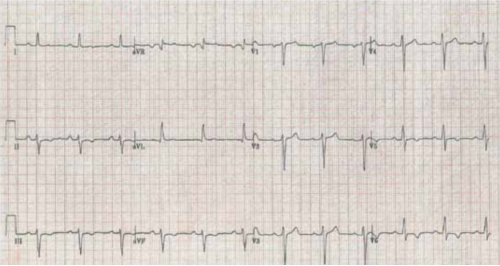
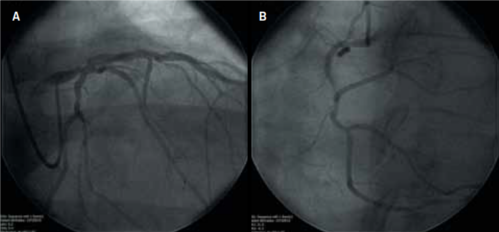
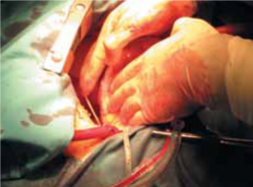
The patient underwent coronary artery bypass grafting (CABG). The left internal mammary artery (LIMA) was harvested but not used, owing to fibrotic changes in its middle half consequent upon the sternal fracture sustained 10 years ago. There was complete absence of the left half of pericardium and the left mediastinal pleura except for a few rudimentary folds. There was a common left pleural and pericardial cavity and the heart and left lung were lying in contact with each other with no intervening pericardium and pleura. The heart was in extreme left intrapleural or, strictly, left ‘intracoelomic’ position, lying in contact with left lateral chest wall and ribs. The left phrenic nerve was lying free within this left ‘coelomic’ cavity (figure 3). Employing cardiopulmonary bypass and cold blood cardioplegic arrest, aortocoronary saphenous vein bypass grafts were constructed to left anterior descending (LAD), diagonal, intermediate and right coronary arteries. Bypass was discontinued uneventfully. Even if LIMA had been normal, it would have been impossible to use it as a pedicled graft owing to the extreme left-sided position of the heart. No attempt was made to reconstruct the pericardium. The patient made an uncomplicated recovery. Post-operative echocardiogram showed odd appearance of left atrial indentation possibly due to abnormal rudimentary pericardial folds. Computed tomography (CT) scan confirmed left pleuropericardial agenesis with a malpositioned heart with normally related ventricles lying entirely within left hemithorax (figure 4). Patient was discharged home after seven days and was well at six-week follow-up.
Discussion
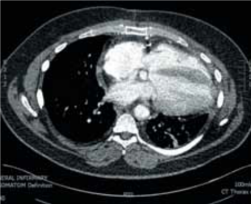
On the ventral aspect of the pharyngeal part of the primitive foregut, the intraembryonic coelom forms an elongated sac on either side of the primitive paired tubular heart. These paired cavities coalesce in the midline and form the pericardial sac. Pericardial sac communicates caudally, on either side of the foregut, with the peritoneal cavity through a narrow corridor called the pleural passage. This pleural passage, the precursor of the future pleural cavity, communicates, on one hand, with the pericardial cavity on either side through an opening called the pleuropericardial canal and, on the other, with the peritoneal cavity through another opening called the pleuroperitoneal canal. The pleuropericardial canal is closed on either side by the growth of a ridge-like band of mesodermal tissue from the lateral body wall, covering the ducts of Cuvier as they pass across the canal to the sinus venosus, situated within the septum transversum. The growth of lungs within the pleural cavities laterally and cranially also helps close the pleuropericardial openings by causing approximation of somatic and splanchnic walls by the overgrowth of mesoderm, called pleuropericardial membrane, overlying the cranial limb of the previously described pulmonary ridge of Mall. A similar process results in closure of the pleuroperitoneal canal. The right pleuropericardial canal closes earlier than the left because the right duct of Cuvier, which gives rise to the intrapericardial part of the superior vena cava, is much larger than the left. The left duct of Cuvier, on the other hand, is much smaller, being represented in later life by the vestigial oblique vein of left atrium and the ligament of left vena cava, and, hence, failure of closure of left pleuropericardial canal is more common. Left pleuropericardial agenesis, thus, represents a developmental abnormality where left lung and heart share a common coelomic cavity as a result of the failure of closure of left pleuropericardial opening (figure 5). The mesodermal growth from the lateral body wall and the development of pleuropericardial membrane does not take place, there is no pericardium or mediastinal pleura separating the heart and lungs, and the phrenic nerves, which gain the diaphragm by passing caudally closely applied to the mediastinal pleura, lie free within the common anomalous left pleuropericardial coelom.1
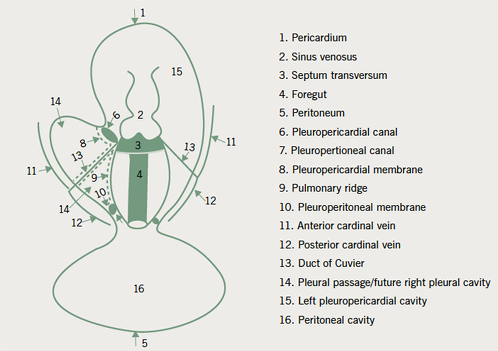
Occurrence
Left pleuropericardial agenesis is an extremely rare entity, although congenital complete absence of pericardium is estimated to occur in one in 10,000 to 14,000 people.2 Out of 364 cases of isolated pericardial agenesis, Letanche et al found 70% on the left side, 4% on the right side and 17% inferiorly.3 From a purely kinetoanatomic point of view, Beppu et al. had echocardiographic evidence of extreme left-sided location of heart in end diastole in left lateral decubitus position due to release from the left pericardial support and a resultant exaggerated swinging motion in systole to restore the apex to near normal position. There was overall enlargement of the right ventricular cavity in left lateral decubitus position in seven patients with total absence of pericardium with excessive increase in hydrostatic pressure.4,5 Izumi et al., using pulsed Doppler echocardiography in eight patients with pericardial defects, concluded that an intact pericardium, by maintaining negative intrapericardial pressure, minimises the influence of posture on cardiac haemodynamics so that each chamber is uniformly expanded for its filling.6 Borrego et al. found diminished tolerance of the right ventricle when faced with acute pressure overload in the absence of pericardium in an experimental study.7 Looking at the relationship between left ventricular torsional deformation and regional myocardial function as measured by longitudinal, circumferential and radial strain patterns, Tanaka et al., on M-mode and two-dimensional echocardiography, in five patients with congenital total absence of left pericardium, found poor development of left ventricular (LV) torsion with pericardial defects, although LV regional myocardial function was not affected.8 Elaborating further on the role of pericardium, Chang et al., in a study on 11 mongrel dogs, concluded that absent pericardium reduced LV twist yet did not affect LV systolic function due to a corresponding compensatory increase in LV radial strain.9
Left pericardial agenesis may be partial or total. While total pericardial agenesis has generally been conceded to be asymptomatic, there have been anecdotal reports of left atrial appendage herniation10 and incarceration, and sudden death with partial agenesis.11
Diagnosis
Pre-operative diagnosis is rarely made. Pain brought on by assumption of left lateral decubitus position and relieved by change of position in partial left pericardial agenesis13 has been described as having symptoms mimicking myocardial infarction2 and syncope.14 On physical examination in the supine position, the precordial impulse is displaced laterally. In the left lateral position, however, the apical impulse is felt in a more medial position. This apparent paradoxical movement of the apical impulse is due to an exaggerated swinging motion of the heart in systole and may be characteristic of pericardial agenesis.15 There may be a systolic left second space murmur.14
Chest X-ray shows marked levocardia, which becomes worse with patient on left side, and interposition of the lung tissue between the base of the heart and the diaphragm and between aorta and pulmonary artery, features considered pathognomonic of left pleuropericardial agenesis.14,16 Diagnosis has been confirmed by diagnostic ‘pneumocoelom’ or actual delineation of the pericardial defect by the communicating left pneumothorax and the pneumomediastinum.13,17
ECG demonstrates right bundle branch block (RBBB), clockwise rotation of heart, T-wave abnormalities and leftward displacement of transition zone in precordial leads.14,18-20 Echocardiographic findings can mimic those associated with right ventricular volume overload with paradoxical interventricular septal movement, sometimes mimicking atrial septal defect (ASD),21 apparent right-sided enlargement with unusual bulging of the apex of right ventricle, cardiac hypermobility and an abnormal swinging excessive basculant heart movement. Also, echocardiographic windows are unusual. Thus, there may be absence of pericardial echo laterally, the four-chamber view may be possible only with the transducer in posterior position and sometimes echocardiographic interrogation may be possible only with patient on right side when it is normal.14-16,18,21-23
CT scan shows absent left pericardium, absent preaortic recess (present in all normal individuals), abnormal presence of lung tissue between the aorta and pulmonary artery, and also between pulmonary artery and left auricle, and, generally, between heart and other intrathoracic structures.2,21,24,25 Visualisation of ligamentum arteriosum on CT scan is considered by some authors to be a characteristic sign for congenital absence of left pericardium.26
Magnetic resonance (MR) scan is considered diagnostic and confirms all the findings seen on CT scan.14,16,21,24,25 Von Bernuth et al. reported fluoroscopic and angiographic demonstration of a protruding shadow along left heart border due to herniating left atrial appendage in partial pericardial defect.20 D’Altorio and Cano found an unusual scintillation camera image of the lung showing perfused lung between the heart and diaphragm and a prominence in the area of the pulmonary artery in patients with congenital absence of pericardium, a finding that was not duplicated in 500 other gamma images of the lung in normal subjects.27
Left pericardial or pleuropericardial agenesis has been found to co-exist with a variety of cardiac conditions. While some of these conditions may be incidental, some have embryological significance. These include diaphragmatic hernia and ASD,28 extralobar pulmonary sequestration mimicking thymoma,29 bilateral congenital diaphragmatic hernia,30-32 Pallister-Killian syndrome with tetrasomy 12p,33 epigastric congenital diverticulum of right ventricle,34 cor triatriatum,35 left lower lobe bronchiectasis,36 bronchogenic cyst, ASD, mitral valve prolapse and hypospadias,37 Pentalogy of Cantrell,38,39 Holt-Oram syndrome with TBX5 mutation,40 ruptured type A dissection with haemothorax but no tamponade,41 anterior and posterior midline field defects including sternal, diaphragmatic and cardiac defects including tricuspid atresia and septal defects,42 VATER association,43 straight back syndrome,44 congenital left atrial aneurysm,45 Marfan syndrome,46 ASD with sick sinus syndrome,47 anomalous phrenic nerves,48 mitral valve prolapse49 and double-chambered right ventricle and anterior leaflet aneurysm of tricuspid valve.50
The recognised complications of partial or total left pericardial agenesis include incarceration of heart tissue and tricuspid valvular regurgitation. While left atrial appendage most commonly is involved,10 left ventricular51 and biventricular constriction in a patient with hypoplastic left heart syndrome12 has been described in partial defects. Tricuspid regurgitation results from tricuspid chordal or leaflet disruption as a result of luxation of heart into the left pleural cavity and the resultant distortion of right ventricular geometry.52-58 There have been a few reports of patients with history of previous sternal trauma who presented later with tricuspid regurgitation and were incidentally found to have pericardial agenesis.52,56
Coronary artery disease has been described with left pleuropericardial agenesis,28,59 while Brulotte et al. described the case of a 49-year-old woman with total left-sided pleuropericardial agenesis and acute myocardial necrosis in the absence of obstructive coronary artery disease.60 A 43-year-old man had a bridle stricture of right and left margins of heart caused by herniation of heart through a partial pericardial defect with matching strictures of right and left coronary arteries.61 Another 68-year-old man underwent concomitant congenital diaphragmatic hernia repair, ASD closure and CABG.28 Gersbach et al. had earlier described elective coronary artery surgery in a patient seriously complicated by left intrapleural location of heart due to left pericardial agenesis.59
Only a few cases of pleuropericardial agenesis have been diagnosed pre-operatively or antemortem. Most of the patients are found by chance during surgery or on induction of artificial pneumothorax when a concomitant and unintended pneumomediastinum develops.44 Nisanoglu et al. described left haemothorax in the absence of tamponade in a patient with type A dissection and ascending aortic rupture in a patient with left pleuropericardial agenesis.41
Treatment
Surgery is generally recommended for partial agenesis because of risks of strangulation in the rare event when diagnosis is made pre-operatively.16,62 Coronary artery surgery may be complicated in a patient with left partial pericardial agenesis (LPPA) due to increased distance between the LIMA and LAD due to extreme left intrapleural location of the heart.63 Gregori et al. described a major disproportion between recipient mediastinal cavity and donor heart in a patient with LPPA necessitating the placement of donor heart on the left diaphragm muscle below the left lung.64 Kostiainen et al. described restoration of pericardial continuity in partial LPPA by pericardioplasty.13 Gatzoulis et al. identified 10 patients from the Toronto hospital registry with complete absence of pericardium (CAP) – four underwent pericardioplasty, three for debilitating symptoms and one for left atrial appendage herniation.25 Van Son found 15 patients with partial absence of pericardium (PAP) or CAP over a 39-year period who underwent surgery for associated cardiac defects – only one had symptoms attributable to pericardial defect.58 Thorascopic diagnosis with closure through left lateral thoracotomy using pig pericardium has been described,65 as has been polytetrafluoroethylene (PTFE) prosthesis for PAP.66
Our patient presented, in the first instance, 10 years ago, following a motorbike accident, with a sternal fracture and a liver laceration, both of which were managed conservatively. Echocardiogram was done and cardiac injury or hemopericardium ruled out. Biventricular function was good. The echocardiographer thought the patient was a poor imaging subject but specifically there were no comments on whether four-chamber view was possible with a more posterior position of the transducer or whether shifting of the patient to the right led to better echocardiographic visualisation. There were also no observations about excessive cardiac mobility or any abnormal swinging motion of the heart. Interestingly, moderate tricuspid regurgitation was found and it was felt that there might have been a traumatic rupture of some portion of the tricuspid valve apparatus, even though this was managed conservatively. With the benefit of hindsight, however, it is more likely that patient has had longstanding tricuspid valve regurgitation secondary to extreme luxation of the heart into the left hemithorax with distortion of the right ventricular inlet and tricuspid annulus. There have been a number of reports of co-existent tricuspid regurgitation with left pleuropericardial agenesis consequent, no doubt, on the distortion of right ventricular geometry due to the left intrathoracic malposition of the heart.52-58 Intriguingly, in a few instances tricuspid regurgitation has been diagnosed after sternal trauma and it is remotely possible that the absence of left pericardium and left mediastinal pleura makes the right ventricle particularly prone to inlet disruption and the consequent tricuspid regurgitation.52,58
MR scan 10 years ago, in our patient, had suggested eventration of left hemidiaphragm and a vague left retroatrial mass was thought to be subdiaphragmatic fat. None of the recognised signs of absent left pericardium, namely, absent preaortic window and lung tissue between aorta and pulmonary artery, between pulmonary artery and left atrial appendage and between the left ventricular base and diaphragm, were discernible.
In our patient, LIMA was not used owing to fibrotic changes in its middle half due to previous sternal trauma. However, even if LIMA had been normal, construction of LIMA anastomosis on its pedicle to LAD would have been difficult owing to extreme dislocation of heart into left chest. A free LIMA anastomosis to LAD with proximal anastomosis to ascending aorta would have been possible. A pedicled right internal mammary artery (RIMA) to LAD would have been even more difficult unless it had been elected to partition the pericardial cavity from the left pleural cavity by constructing a left-sided pericardium. We did not feel any form of pericardioplasty was necessary. There have been rare reports25 of benefits of pericardial reconstruction in patients with complete agenesis in contradistinction to those with partial defects.13,25,62,65,66.
Conflict of interest
None declared.
Key messages
- Left pleuropericardial agenesis is an uncommon condition
- Although diagnosis can be suspected clinically and by various imaging modalities, diagnosis is made after an operation for another condition in the majority of cases
- Partial agenesis can cause chamber or appendage incarceration with disastrous results
- Complete agenesis is usually asymptomatic, although there can be subtle or manifest changes in right ventricular geometry with tricuspid regurgitation
- Technique of coronary arterial surgery may need to be modified due to extreme cardiac malposition, particularly in relation to pedicled arterial conduits
References
- Basu BN, Pan M, eds. Subdivisions of Coelom. In: Mustafi’s Human Embryology. Calcutta: SK Mustafi, 1975;6:109–14.
- Razdan R, Greenberg S, Perez LJC, Torstensen G. Congenital complete absence of the pericardium mimicking myocardial infarction: a case report and literature review. Conn Med 2009;73:585–8.
- Letanche G, Gayet C, Souquet PJ et al. Agenesis of the pericardium: clinical, echocardiographic and MRI aspects. Revue de Pneumologie Clinique 1988;44:105–09.
- Beppu S, Matsuhisa M, Izumi S et al. Pericardial defect: roles of the pericardium on kinetoanatomic changes of the heart influenced by patients’ postures. J Cardiol 1986;16(suppl):193–205.
- Beppu S, Naito H, Matsuhisa M, Miyatake K, Nimura Y. The effects of lying position on ventricular volume in congenital absence of the pericardium. Am Heart J 1990;120:1159–66. http://dx.doi.org/10.1016/0002-8703(90)90131-G
- Izumi S, Beppu S, Matsuhisa M et al. The physiological role of the pericardium: studies based on right heart inflow dynamics in cases of left side pericardial defect. J Cardiol 1987;17:129–38.
- Borrego JM, Ordonez A, Gutierezz E et al. Integrity of the pericardium. Its beneficial effects on the protection of the right ventricle in the presence of acute pulmonary hypertension. Ann Thorac Cardiovasc Surg 1998;4:332–5.
- Tanaka H, Oishi Y, Mizuguchi Y et al. Contribution of the pericardium to left ventricular torsion and regional myocardial function in patients with total absence of the left pericardium. J Am Soc Echocardiogr 2008;21:268–74. http://dx.doi.org/10.1016/j.echo.2007.05.035
- Chang SA, Kim HK, Kim YJ, Cho GY, Oh S, Sohn DW. Role of pericardium in the maintenance of left ventricular twist. Heart 2010;96:785–90. http://dx.doi.org/10.1136/hrt.2009.182345
- Rubio AA, Herrero PC, Sanchez CJM, de Mora MM. The imaging diagnosis of pericardial agenesis. Revista Espanola de Cardiologia 1999;52:211–14.
- Leguerrier A, Milton J, Milon D et al. Agenesis of the left pericardium. Apropos of 3 anatomo-surgical observations. Bulletin de l Association des Anatomistes 1979;63:479–88.
- Puvabanditsin S, Garrow E, Biswas A, Davydov A, Gomez M, Liangthanasarn P. Congenital partial pericardial defect in a neonate; a case report. Am J Perinatol 2003;20:121–3. http://dx.doi.org/10.1055/s-2003-40011
- Kostiainen S, Maamies TJ. Congenital partial absence of the left pericardium. Annales Chirurgiae et Gynaecologiae Fenniae 1975;64:40–3.
- Ferrante A, Pedi C, Cusumano S, Malfitano D. Agenesis of the left pericardium: report of a case. Giornale Italiano di Cardiologia 1994;24:1121–4.
- Hermann H, Raizner AE, Chahine RA, Luchi RJ. Congenital absence of left pericardium: an unusual palpation finding and echocardiographic demonstration of the defect. Southern Medical Journal 1976;69:1222–5. http://dx.doi.org/10.1097/00007611-197609000-00036
- Scapellato F, Imparato A, Brunnetto A, Temporelli PL, Giannuzi P. A paradigmatic case of partial agenesis of the pericardium. Giornale Italiano di Cardiologia 1996;26:1187–93.
- Pickhardt PJ. Congenital absence of the pericardium confirmed by spontaneous pneumothorax. Clin Imaging 1998;22:404–07. http://dx.doi.org/10.1016/S0899-7071(98)00070-9
- Parra C, Kauffmann R, Daza S, Teran F. Total congenital absence of left pericardium in 3 cases. Revista Medica De Chile 1992;120:1144–8.
- Di Pasquale G, Ruffini M, Piolanti S, Gambari PI, Roversi R, Pinelli G. Congenital absence of pericardium as unusual cause of T wave abnormalities in a young athelete. Clin Cardiol 1992;15:859–61. http://dx.doi.org/10.1002/clc.4960151112
- von Bernuth G, Nissen H, Lang D, Hofstetter R. Congenital defects of left-sided pericardium. Zeitschrift fur Kardiologie 1976;65:1022–32.
- Garnier F, Eicher JC, Philip JL et al. Congenital complete absence of left pericardium: a rare cause of chest pain or pseudo-right heart overload. Clin Cardiol 2010;33:52–7. http://dx.doi.org/10.1002/clc.20607
- Connolly HM, Click RL, Schattenberg TT, Seward JB, Tajik AJ. Congenital absence of the pericardium: echocardiography as a diagnostic tool. J Am Soc Echocardiogr 1995;8:87–92. http://dx.doi.org/10.1016/S0894-7317(05)80362-1
- Payvandi MN, Kerber RE. Echocardiography in congenital and acquired absence of the pericardium. An echocardiographic mimic of right ventricular volume overload. Circulation 1976;53:86–92.
- Milllaire A, Goullard L, Tison E, Remi-Jardin M, Santre C, Ducloux G. Unilateral left agenesis of the pericardium. Contribution of cardiac imaging. Archives des Maladies du Coeur et des Vaisseaux 1990;83:275–80.
- Gatzoulis MA, Munk MD, Merchant N, Van Arsdell GS, McCrindle BW, Webb GD. Isolated congenital absence of the pericardium: clinical presentation, diagnosis and management. Ann Thorac Surg 2000;69;1209–15. http://dx.doi.org/10.1016/S0003-4975(99)01552-0
- Vesley T, Julsrud PR. Congenital absence of the pericardium and its relationship to the ligamentum arteriosum. Surg Radiol Anat 1989;11:171–5. http://dx.doi.org/10.1007/BF02096477
- D’Altorio R, Cano JY. Congenital absence of the left pericardium detected by imaging of the lung: a case report. J Nucl Med 1977;18:267–8.
- Ventura F, Neri M, De Stefano F, Finseschi V. Sudden cardiac death in a case of undiagnosed pericardial agenesis. Revista Espanola de Cardiologia 2010;63:1103–05. http://dx.doi.org/10.1016/S0300-8932(10)70236-0
- Hotouras A, Shahin Y. Pericardial agenesis: a rare cause of pain. Postgrad Med J 2010;86:380–1. http://dx.doi.org/10.1136/pgmj.2009.096164
- Eyileten Z, Arikbuka M, Yazicioglu L, Ozyurda U. Left pericardial agenesis in a patient with sinus venosus type atrial septal defect. Anadolu Kardiyoloji Dergisi 2007;7:205–06.
- St Peter SD, Shah SR, Little DC, Calkins CM, Sharp RJ, Ostlie DJ. Bilateral congenital diaphragmatic hernia with absent pleura and pericardium. Birth Defects Res A Clin Mol Teratol 2005;73:624–7. http://dx.doi.org/10.1002/bdra.20173
- Tebbruegge MO, Rennie JM, Haugen SE. Congenital absence of the pericardium associated with congenital diaphragmatic hernia and hepatic hemangioendothelioma: case report and review of the literature. Pediatr Surg Int 2005;21:557–9. http://dx.doi.org/10.1007/s00383-005-1371-3
- Zakowski MF, Wright Y, Ricci A Jr. Pericardial agenesis and focal aplasia cutis in tetrasomy 12p (Pallister – Killian syndrome). Am J Med Genet 1992;42:323–5. http://dx.doi.org/10.1002/ajmg.1320420313
- Gille P, Verney R, Meley M, Aubert D, Delafin J, Mourot M. Epigastric congenital diverticulum of the right ventricle. Resection during the neonatal period. Chirurgie Pediatrique 1979;20:349–54.
- Jimanez MM, Franco VJS, Gutierezz BR. Cor triatriatum with pericardial agenesis. Thorax 1969;24:667–72. http://dx.doi.org/10.1136/thx.24.6.667
- Sivrikoz MC, Durceylan E, Boztepe H, Birdane A. Congenital total absence of pericardium in a patient with left lung lower lobe bronchiectasis. Anadolu Kardiyoloji Dergisi 2011;11:81–3.
- Ozpolat B, Dogan OV. Absence of pericardium in combination with bronchogenic cyst, atrial septal defect, mitral valve prolapsed and hypospadias. Anadolu Kardiyoloji Dergisi 2009;9:16–17.
- Yuan SM, Shinfield M, Mishaly D. An incomplete pentalogy of Cantrell. Chang Gung Med J 2008;31:309–13.
- Laloyaux P, Veyckemans F, Van Dyck M. Anaesthetic management of a prematurely born infant with Cantrell’s pentalogy. Paediatr Anaesth 1998;8:63–6.
- Dias RR, Albuquerque JM, Pereira AC et al. Holt-Oram syndrome presenting as agenesis of the left pericardium. Int J Cardiol 2007;114:98–100. http://dx.doi.org/10.1016/j.ijcard.2005.09.056
- Nisanoglu V, Erdil N, Battaloglu B. Complete left sided absence of the pericardium in association with ruptured type A dissection complicated by severe left hemothorax. Tex Heart Inst J 2005;32:241–3.
- Cottrill CM, Tamaren J, Hall B. Sternal defects associated with congenital pericardial and cardiac defects. Cardiol Young 1998;8:100–04. http://dx.doi.org/10.1017/S1047951100004716
- Lu C, Ridker PM. Echocardiographic diagnosis of congenital absence of the pericardium in a patient with VATER association defects. Clin Cardiol 1994;17:503–04. http://dx.doi.org/10.1002/clc.4960170909
- Iwafuchi Y, Okada Y, Kato T, Horikawa K, Terashima M, Kobayashi S. A case of complete absence of left pericardium coexisting with straight back syndrome. Kokyu To Junkan 1991;39:1055–9.
- Vargas-Barron J, Sanchez-Ugarte T, Keirns C. The differential diagnosis of partial absence of left pericardium and congenital left atrial aneurysm. Am Heart J 1989;118:1348–50. http://dx.doi.org/10.1016/0002-8703(89)90033-1
- Corti P, Pagnoni N, Mangano G, Bordiga G, Lorini G. Congenital absence of pericardium in a case of a variant of Marfan Syndrome. Recenti Progressi in Medicina 1989;80:63–6.
- Chiariello M, Indolfi C, Condorelli M. Congenital absence of the pericardium associated with atrial septal defect and sick sinus syndrome. Int J Cardiol 1984;5:527–30. http://dx.doi.org/10.1016/0167-5273(84)90091-3
- Orellana J, Aberdeen E, Baron MG. Anomalous phrenic nerves in a patient with congenital absence of the left pericardium. Mt Sinai J Med 1981;48:443–5.
- Pocock WA, Lakier JB, Benjamin JD. Billowing mitral valve in association with absent left pericardium. S Afr Med J 1977;52:813–16.
- Matsumoto M, Maeda H, Tanaka T, Hiratsuka H, Kawamura T. Double chambered right ventricle combined with anterior leaflet aneurysm of the tricuspid valve and complete absence of the left pericardium. Nippon Kyobu Geka Gakkai Zasshi 1976;24:1446–54.
- Murat A, Artas H, Yilmaz E, Ogur E. Isolated congenital absence of the pericardium. Pediatr Cardiol 2008;29:862–4. http://dx.doi.org/10.1007/s00246-008-9212-5
- Farcasso A, Pothen P, Galluchi V. Tricuspid regurgitation caused by blunt chest trauma in association with pericardial agenesis; surgical correction after eight years. Thorax 1982;37:75–6. http://dx.doi.org/10.1136/thx.37.1.75
- Rashid A, Ahluwalia G, Griselli M et al. Congenital partial absence of the left pericardium with tricuspid regurgitation. Ann Thorac Surg 2008;85:645–7. http://dx.doi.org/10.1016/j.athoracsur.2007.08.053
- Chatzis AC, Giannapoulos NM, Sarris GE. Isolated congenital tricuspid insufficiency associated with right-sided congenital partial absence of the pericardium. J Heart Valve Dis 2004;13:790–1.
- Goetz WA, Liebold A, Vogt F, Birnbaum DE. Tricuspid valve repair in a case with congenital absence of left thoracic pericardium. Eur J Cardiothorac Surg 2004;26:848–9. http://dx.doi.org/10.1016/j.ejcts.2004.06.004
- Hwang JJ, Lien WP, Chen JJ, Kuan P, Hung CR. Traumatic rupture of the pericardium with a peculiar chest radiographic finding. Cardiology 1993;83:415–18. http://dx.doi.org/10.1159/000175999
- van Son JA, Danielson GK, Callahan JA. Congenital absence of the pericardium. Ann Thorac Surg 1993;56:1405–06. http://dx.doi.org/10.1016/0003-4975(93)90697-G
- van Son JA, Danielson GK, Schaff HV, Mullany CJ, Julsrud PR, Breen JF. Congenital partial and complete absence of pericardium. Mayo Clin Proc 1993;68:783–7.
- Brulotte S, Roy L, Larose E. Congenital absence of the pericardium presenting as acute myocardial necrosis. Can J Cardiol 2007;23:909–12. http://dx.doi.org/10.1016/S0828-282X(07)70851-6
- Amiri A, Weber C, Schlosser V, Meinertz TH. Coronary artery disease in a patient with a congenital pericardial defect. Thorac Cardiovasc Surg 1989;37:379–81. http://dx.doi.org/10.1055/s-2007-1020358
- Gersbach P, Kaufmann U, Althaus U. Congenital absence of the left pericardium with extreme intrathoracic displacement of the heart. Case report and review of the literature. Eur J Cardiothorac Surg 1996;10:473–6. http://dx.doi.org/10.1016/S1010-7940(96)80121-7
- Kornyei V, Kiss A, Kamaras J. Congenital absence of the left pericardium. Case report and review of the literature. Orvosi Hetilap 1993;134:1703–07.
- Beiras-Fernandez A, Sadoni S, Michel S et al. Off pump coronary bypass in a patient with congenital absence of the left pericardium and an extremely left-rotated heart. Heart Surg Forum 2010;13:63–5. http://dx.doi.org/10.1532/HSF98.20091114
- Gregori F Jr, Cordeiro CO, Croti UA, Gregori TE, Moure O. Heart transplant in a patient with complete absence of the pericardium. Arquivos Brasilieros de Cardiologia 2000;75:249–52.
- Gehlmann HR, van Ingen GJ. Symptomatic congenital complete absence of the left pericardium. Case report and review of the literature. Eur Heart J 1989;10:670–5.
- Chapman JE Jr, Rubin JW, Gross CM, Janssen ME. Congenital absence of pericardium: an unusual cause of atypical angina. Ann Thorac Surg 1988;45:91–3. http://dx.doi.org/10.1016/S0003-4975(10)62407-1
